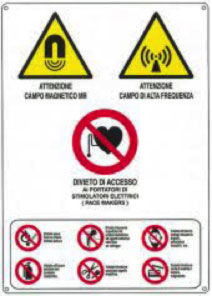Information for Patients with Implantable Devices
Each cardiac device (pacemaker (PM), defibrillator (ICD), resynchronizer (CRT)) has internal functions that protect it from the interference produced by most of the electrical equipment that is normally used in our homes. However, strong magnetic or electric fields may interfere with the normal operation of the device.
These electromagnetic interferences are, however, temporary, and normally do not damage the device, so they stop interfering once you move away from the emission source.
A list of possible equipment that we normally come into contact with in daily practices is provided. For particular equipment or machinery, it is necessary to ask the center that performs the implantation for information.
| However, please note that, in particular, ICD users must pay particular attention to the electrical system and household electrical outlets. If there is not adequate grounding, the devices can release a certain electrical leakage, rarely felt by people, but certainly detected by the defibrillator, which could mistakenly consider it a cardiac arrhythmia and deliver an inappropriate shock. |
| Similarly, ICD users must pay particular attention to the state of maintenance of the devices used, to avoid any electrical leakage. |
Indice dell'articolo
Electronic equipment that can be used safely.
- Electric can openers
- Hairdryer
- Vacuum cleaners
- Paging
- Patient alarm devices
- Fax and copier
- Electric and microwave ovens
- Blenders
- Washing machines and dryers
- Tanning beds
- CD / DVD players
- Personal Computer
- Radio and video recorders
- Electric heaters
- Electric toothbrushes
- Electric or gas stoves
- Remote Controls
- Warmer
- TV or radio speakers
- TV
- Whirlpool tubs
- Video games
Tools that can be used as long as they are not placed over the device (distance of 15-30 cm)
- Manual massagers
- Electric razors
- Cordless telephones (home)
- Cell phones
Tools that can be used but must be kept about 30-60 cm from the device
- Stereo speakers
- Aspirators of foliage
- Chain saws
- Slot machines
- Suction snow plow
- Workshop tools (drills, table saws…)
- Lawnmower
- Remote controls with antennas
Tools that can be used with particular caution and kept more than 60 cm from the device
- CB and police radio antennas
- Arc welders
- Engines and alternators that are turned on, especially those found in vehicles (avoid leaning over the hood of a turned on car because current generators create magnetic fields that could interfere with the correct operation of the device)
- Being in the driver’s or passenger’s seat is absolutely safe!
Tools that should not be used
|
Other possible electromagnetic interference
- Burglar and shoplifting systems in shops
You can easily cross at a normal pace, avoiding to stop near or lean on the columns.
- Bank and airport security systems
The metal parts of the devices could cause the alarm system of the metal detectors to sound, but the passage under the arches does not damage the device. Advise security personnel that you carry a cardiac device and, if searched with a manual metal detector, ask them not to linger long with the instrument on the device.
- Cell phones
Mobile phones can be used safely as long as they are kept at a distance of 15 cm from the pacemaker, for example by placing the mobile phone on the ear opposite the side of the implant. Do not carry the mobile phone in a breast pocket near the implant site.
Medical and dental procedures that do not damage the device.
- Dental drills and dental cleaning equipment
- Radiography
- TAC
- Ultrasound
- ECG machines
- Mammography (be careful not to damage the device by crushing it)
Before each surgery, inform the dentist or doctor of the presence of the cardiac device, contacting the implant center if in doubt.
Medical and therapeutic procedures allowed only under particular conditions or not recommended
Some medical and therapeutic procedures may affect the proper functioning of the pacemaker. Inform doctors and therapists of the presence of the pacemaker to take the necessary precautions.
- Magnetic resonance
In general, MRI should be avoided, because the exam uses a strong magnetic field. Only some devices called MRI-conditional, under certain conditions can be subjected to this examination.
Also avoid entering the rooms where this examination is performed. This is the signal that distinguishes them:

- Diathermy
This procedure uses an electric field to bring heat to the body’s tissues and should be avoided.
- Electrocautery
This technique is used in the operating room during surgical procedures to stop bleeding. It could create problems, particularly in pacemaker patients or ICD carriers. If necessary, specific programming or inactivation of the device is required.
- External defibrillation
This is a procedure that is used in emergency medical situations. It can be carried out, but it is important to contact the implant center afterwards and check the correct operation of the device as soon as possible.
- Lithotripsy
This is a procedure used to crush urinary tract stones (kidney stones) that can be carried out by taking certain precautions not to damage the device, which must be checked again after treatment.
- Radiotherapy for the treatment of tumors
This can be carried out, but not near the area where the pacemaker is implanted. Therefore, it must be carried out with careful precautions, and the device must be checked after treatment.
- TENS- unit of electrical stimulation of the nerves transcutaneously
This is a device that uses electric currents to control chronic pain, and must be avoided.
Obviously this list is not exhaustive, so it is necessary to contact the implantation center if there are doubts about the use of a specific device, tool, medical procedure or equipment.
